Network performance monitoring is a continuous process of measuring, monitoring, and optimizing the performance of your network with the help of performance monitoring tools, often using varied types of telemetry like.
Simple network management protocol gives an organization using network monitoring tools the ability to quickly identify the devices connected to the network, monitor the performance of the network, keep track of changes to the network, or determine the status of network devices on a real-time basis.
Another type of telemetry is the network flow data containing protocols, like NetFlow and jFlow. It can also be labelled as a digital record with information about the connections made over a network by keeping track of details like the source and endpoint IP address, the duration of communication between them, how often the communication takes place, and its duration.
A different form of telemetry network performance tools employ is network packets carrying the data around as packets on a network. Capturing these packets help diagnose and solve network challenges, including assessing a cloud application, planning a migration to the cloud, or network capacity planning.
The Importance of Network Performance Monitoring
Since businesses today rely on a strong and secure network to run their operations and deliver a smooth and user-friendly experience to their customers, monitoring becomes extremely important, and any deterioration in the quality of your network performance impacts business. Businesses of all sizes need a performance monitoring tool to help them monitor problems, anticipate potential disruptions, and address them beforehand. Continuous network monitoring helps them maintain a congestion-free network up and running.
Organizations can also gain an immediate ROI with the right set of network performance tools, as the IT team can focus more on the more critical tasks rather than manually digging and checking on the network performance. Having a network performance tool at their disposal also helps organizations meet their service level agreements concerning network availability, thereby ensuring a satisfied client base. Network performance tools also help validate whether there is a need to upgrade servers by looking at the historical records of your server performance.
Benefits of Network Performance Monitoring Tools
Good customer experience is quintessential for companies, and this also becomes the prime reason to monitor network performance. A network performance tool helps identify slow-performing devices along with findings of such poor performance. These tools focus on the start and end of the data path, focusing on each network node to examine the performance at every point on the network. It also helps monitor the data transfer rate at every signal node and single out devices with poor performance.
Apart from issue identification, a good tool also helps ensure continuous uptime, prevent outages, and detect and troubleshoot CPU and server bottlenecks like utilization, speed, and idle time. Moreover, a good performance monitoring tool allows you to identify bandwidth hogs early on, enabling improved performance. A fully loaded performance monitoring tool also helps monitor and reduce packet loss due to errors and discards indicative of a problem with the switch or the device interacting with the switch. A network performance monitoring tool can also help you monitor your WAN connections, check WAN latency, and identify network traffic across your WAN network. This enables you to allocate resources accordingly to prioritize traffic and react proactively to issues affecting your WAN network.
Top Ten Network Monitoring Tools
While network monitoring tools focus on aspects like performance monitoring, fault monitoring, and account monitoring, they’re also used to examine components such as applications, email servers, and more. While there are several network monitoring tools available in the market, choosing the right device with in-depth research and tracking capability is challenging.
- SolarWinds Network Performance Monitor
- Nagios
- Zabbix
- Spiceworks
- Icinga
- PRTG Network Monitor
- Site 24×7
- Atera
- ManageEngine OpManager
- Zenoss Cloud
We’ve listed the top ten performers in network performance monitoring tools because we know how taxing choosing the right tool can be.
SolarWinds Network Performance Monitor
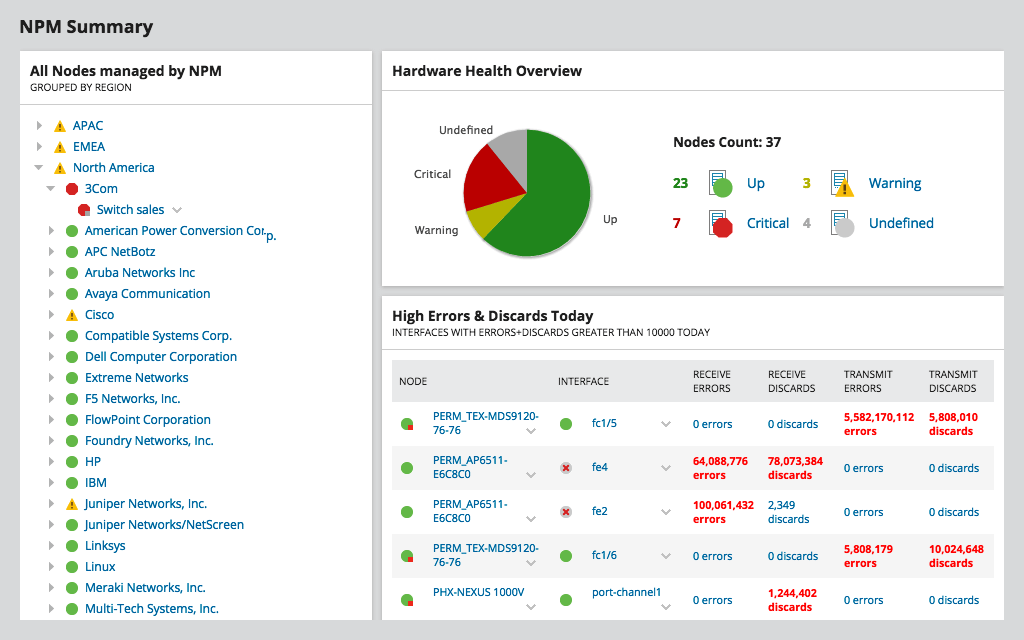
SolarWinds® Network Performance Monitor is a multi-vendor network monitoring tool designed to scale and grow with the requirements of your environment while being cost-effective. While it takes less time to set up, it’s easy to navigate and can track network issues where relevant teams get a notification using its advanced alerting feature. These alerts can also be customized based on simple or complex nested trigger conditions, and for deeper visibility, it gives network insights and intelligent maps. The PerfStack™ feature gives the users the ability to compare different data types side by side—simply drag and drop the metrics to the chart, and PerfStack will overlay them for natural correlation and performance analysis.
SolarWinds NPM constantly monitors the performance and availability of network devices and helps troubleshoot when problems arise. With its intelligent network alerting feature, it apprises you of key performance metrics crossing your pre-defined thresholds, making you the first to know when issues occur. It also helps resolve network connectivity issues quickly, as it tracks and displays your current and historical performance metrics in customizable charts and dashboards.
SolarWinds NPM also uses packet analysis to help you figure out if it’s the application or the network causing poor user experience, helping accelerate resolution time. A few of its key features include:
- Advanced network diagnosis and troubleshooting for on-premises, hybrid, and cloud services with critical path analysis.
- Hop-by-hop scanning along the critical paths by helping view performance, traffic, and configuration details of devices and applications on- premises, in the cloud, or across hybrid environments with NetPath™.
- Response time, availability, and performance of network devices is monitored and displayed, improving operational efficiency with out-of-the-box dashboards, alerts, and reports.
- Automatically discover network devices and typically deploy in about an hour.
With SolarWinds, you get fault, performance, and availability monitoring along with quick detection and diagnosis. It has a customizable topology and dependency-aware intelligent alerts system capable of responding to a wide range of condition checks, correlated events, network topology, and device dependencies. It can automatically discover and map devices, performance metrics, link utilization, and wireless coverage, and automatically calculate exhaustion dates using customizable thresholds based on peak and average usage. With its comprehensive monitoring of the F5 BIG-IP family of products, you can visualize and gain insights on the performance of F5 service delivery environment, and its drag-and-discover feature lets you create an interactive performance chart network with real-time network performance metrics alongside interactive charts and graphs from your network devices.
Nagios
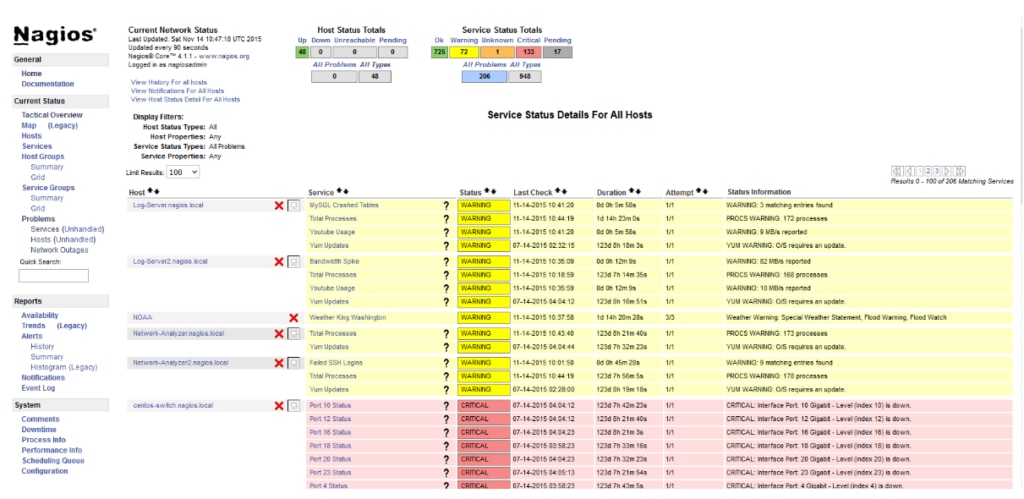
Nagios is an open-source tool with an interactive web interface to monitor performance. It lets you track the current network status with your host status totals and service status totals, and the GUI is color-coded to help you see elements quickly.
Nagios supports external plug-ins to create and use in the form of executable files, plus shell scripts to track and collect metrics from every hardware and software in your network. Nagios lets you monitor performance events through its color-coded alert system that sends out notifications by email and SMS, making it easier to prioritize critical alerts. You can also use APIs to integrate other services into it. You can also check thousands of community plug-ins readily available on the Nagios Exchange if you need more options and additional features.
Nagios has two different plans. One is an open-source, free version limited to monitoring capabilities, and the other is a commercial version
with added features along. The commercial version is accessible due to its external plug-ins and gives a centralized view of the entire IT infrastructure,
including detailed device status information. The tool has escalation capabilities and proactively measures network downtime.
Zabbix

Zabbix is a free open-source tool with real-time monitoring of metrics collected from servers, virtual machines, and network devices via multi-platform Zabbix agents, SNMP and IPMI agents, agentless monitoring of user services, custom methods, calculation and aggregation, and end-user web monitoring. It combines network, server, cloud, application, and services monitoring in a single unified solution. Its auto-discovery feature lets you locate network devices automatically and adds them to monitor. Zabbix can also detect configuration changes automatically, so you can tell if a device has been updated or not. Its preconfigured templates make it easier for you to configure the program for monitoring. (For example, there are specific preconfigured templates for vendors such as Cisco, Hewlett Packard Enterprise, Dell, and Intel to name a few.) You can access more templates from the community site. Zabbix is a top Linux network monitoring tool, and its auto-discovery and templates make the program straightforward to deploy. Zabbix is known for the ability to customize its monitoring capabilities via any scripting or programming language.
Spiceworks
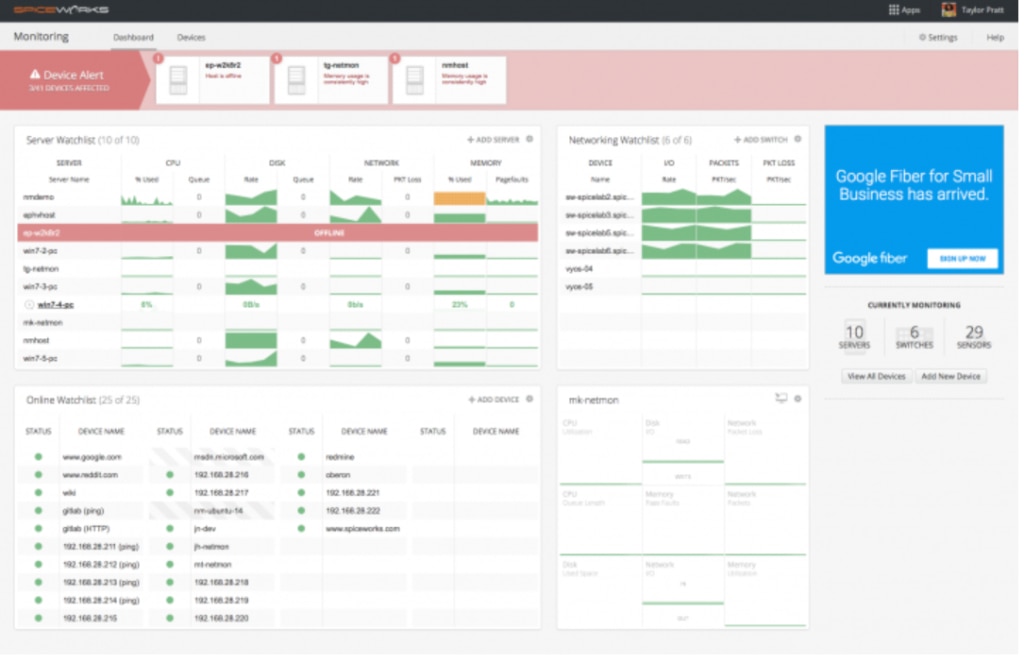
Spiceworks is a popular free network monitoring tool. Its web-based GUI allows you to access the dashboard and monitor the availability of your network infrastructure in real-time. It also integrates with Spiceworks Inventory and Cloud Help Desk to help you track your network inventory more effectively. For example, with Spiceworks Inventory, you can track information on IP addresses, OS, MAC addresses, and more. Its alerting system lets you know about performance fluctuations via email.
Spiceworks can prove to be an ideal choice for smaller enterprises looking for an affordable network performance monitoring solution. It lets you start monitoring typically in minutes and the connectivity dashboard is simple to set up. All you have to do is to install the monitoring agent on any workstation/server, configure the application URLs, and start monitoring. Spiceworks helps users gain real-time insights and spot sluggish network connections or overwhelmed applications either hosted in the data center or the cloud.
Icinga
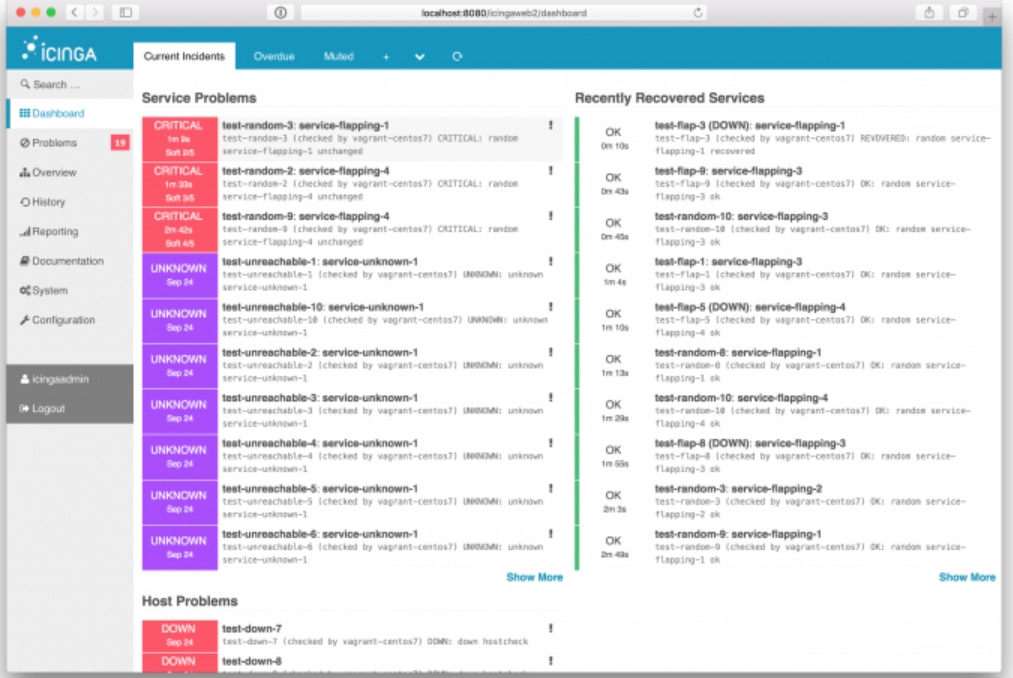
Icinga is considered a Nagios backwards-compatible tool, meaning if you have a Nagios script, you can port it over with relative ease because it has been developed on top of MySQL and PostgreSQL. Icinga is an open-source network monitoring tool that monitors the performance of your network, cloud-service, and data center and can be configured through the GUI or with any domain specific language (DSL).
To get an overview of performance, you can log in to the GUI and use the dashboard to see whether there are problems with performance or availability and color-code them according to severity. Extensions, or Icinga Modules, allow you to add more functions to the program. For example, the Icinga Module for vSphere lets you monitor virtual machines and host systems. And from the Icinga Exchange, you can download a whole array of community-created plugins for free.
Overall, Icinga is a scalable solution that provides control over how you manage your environment. It’s available for Red Hat, Ubuntu, Fedora, Raspbian, and Windows and its main features include an efficient monitoring engine across the entire infrastructure. It also gives you the power to watch any host and application, and the monitoring engine can monitor a complete data center and clouds.
It comes packed with an appealing web UI where custom views can be built by grouping and filtering individual elements and combining them in a custom dashboard.
PRTG Network Monitor

PRTG leverages SNMP, packet sniffing, and WMI to monitor networks. Its intuitive dashboard lets you see new alarms, critical devices, warning devices, and healthy devices. Each of these is color-coded and used in the main screen display to denote the health status of devices. It also includes SNMP monitoring, bandwidth monitoring, scanning for devices by IP segment, custom dashboards, threshold-based alerts, reports, and customizable network maps. Its other features include:
- Comprehensive sensor type selection
- Remote management via a web browser, PocketPC, or Windows client
- Multiple location monitoring
- Alerts and notifications for outages via email, ICQ, pager/SMS, and more
Site 24×7
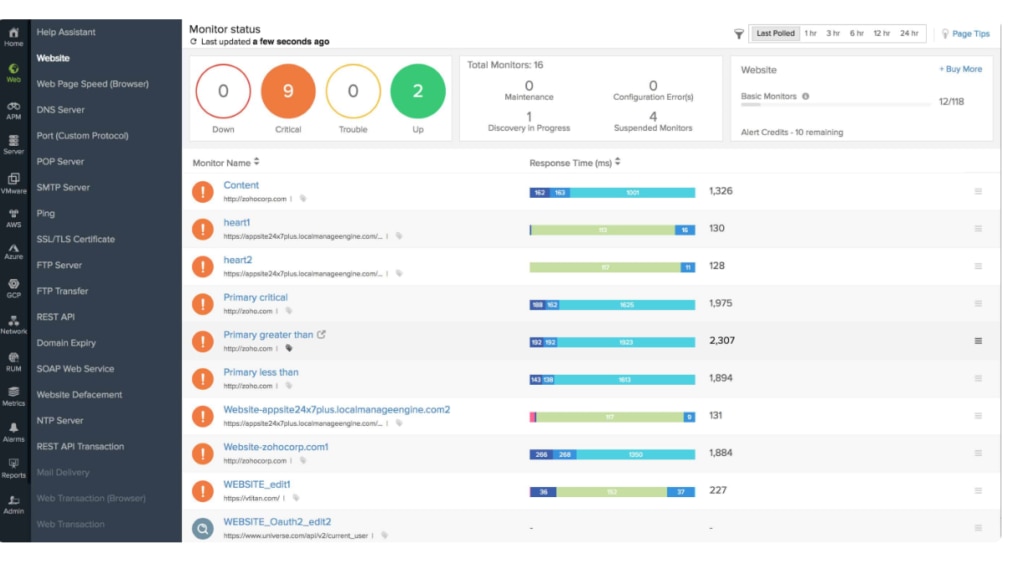
Site 24×7 is a cloud-based network monitoring tool that uses SNMP to monitor your network. It’s easy to configure and automatically discovers SNMP devices by IP range. Users can start monitoring out of the gate without setting everything right from scratch. You can track various metrics such as memory utilization, CPU usage, disk utilization, active session count, and more.
A bulk of user monitoring experiences take place through the health console, where you can get an overview of device performance. It also comes with network maps to see the network topology, allowing more visibility to a problem. It takes care of SNMP and the application and website monitoring, including user experience, making the transition between onboarding, automatically discovering devices, and using device templates very smooth.
Atera

Atera is a network monitoring tool designed for use by managed service providers (MSPs) and hosted on the cloud. This tool has a range of monitors, including server and application monitors. However, the client site will require agents installed on it. The mobile application enables system administrators to check in on the status of the monitored network from anywhere. Because Atera involves a high degree of automation, the ability to log in to the network from any system is essential. The tool monitors the client’s network and only requires human attention when a problem arises.
Atera also provides a mechanism for network discovery and is available in three versions: Pro, Growth, and Power. It also has a robust reporting, analytics, and alerts features.
ManageEngine OpManager

ManageEngine OpManager monitors network operations. Although this tool has server monitoring capabilities, network monitoring is the core function of OpManager. ManageEngine OpManager doesn’t oversee the traffic inflow but follows the status of network equipment.
Its wireless network monitoring module comes in handy as it displays the signal strength of wireless access points on the premises. OpManger is available in four editions: Free, Standard, Professional, and Enterprise. A few of its features include:
- Uninterrupted monitoring of Wide Area Network(WAN) link availability
- Checking VoIP call quality across Wide Area Network(WAN) infrastructure
- Visualizing the automatic L1/L2 network mapping
Zenoss Cloud
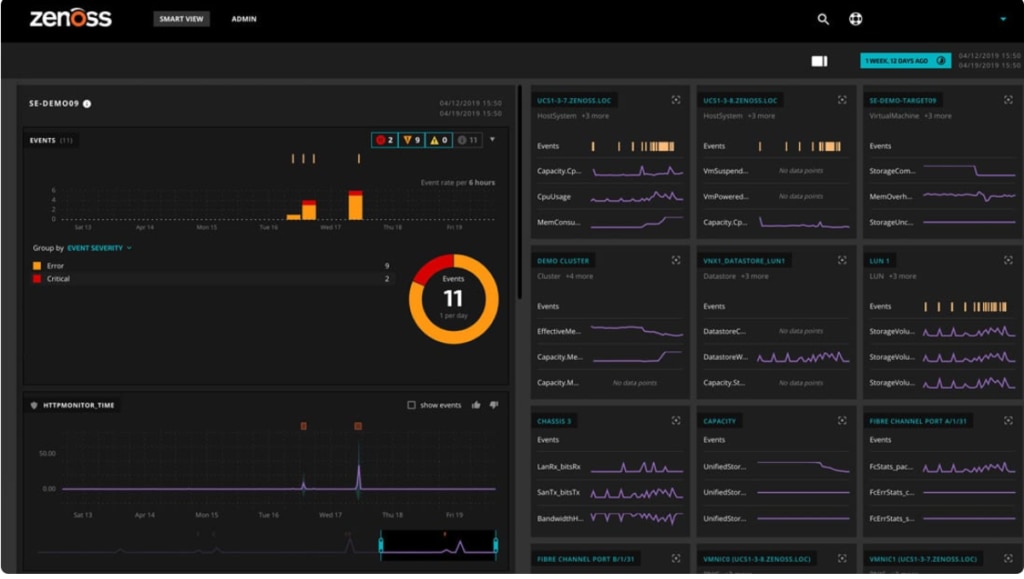
Zenoss Cloud is a performance monitoring for multi-cloud environments. With this performance monitoring tool, you can monitor everything from network devices to applications to logs to event data in real time. Its intelligent dashboard provides you with a complete perspective of performance concerns. It uses machine learning-based anomaly detection to automatically detect performance deviations. Once an anomaly is detected, root-cause analysis helps the user drill-down to the root cause of the problem. A range of plug-in extensions called ZenPacks are available, encompassing everything from devices to services. There are open-source plug-ins for Amazon Web Services, Apache HTTP Server, Dell, Docker, HP, and Cisco, to name a few.
Summing Up
Network performance monitoring solutions can help companies prevent a disaster even before it happens. They can deliver visualizations on key performance metrics while automatically generating performance reports, which ideally include both recent and historical data. While it’s useful for tracking the performance of your systems, it also helps organizations deal with security threats invading networks. With an accurate performance monitoring tool, organizations can be alerted to events that might indicate the presence of malware in a system, for example, abnormal data transfers, failing systems, etc.
To truly understand network performance, organizations must observe every aspect of a network because any portion of it businesses skip monitoring could be a cause of performance issues and in turn might affect the entire environment. Network monitoring tools are a must-have to keep networks organized and well-maintained—they provide visibility to manage devices and help ensure they’re available around the clock for the organization and its users.

